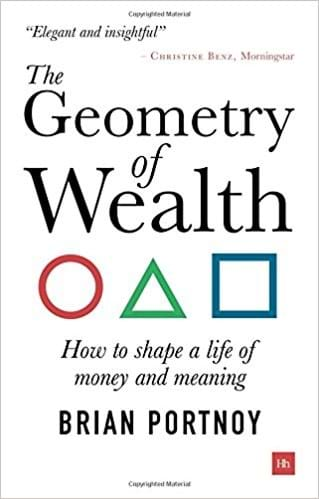Shaping a Life of Money and Meaning

Towards the end of 2017, I wrote a post highlighting some of the forthcoming investing, business and personal finance books I was most looking forward reading in 2018. Absent from that list was Brian Portnoy’s new book The Geometry of Wealth, for no other reason that I wasn’t aware of its pending release at the time. Had I known about it, and the impact it would have on me both personally and professionally, it would have ranked at the top of my list.
In his day job as the Director of Investment Education for Virtus Investment Partners, Brian has spent years travelling across the country speaking to and talking with financial advisors and their clients. As fellow Chicago residents, I have had the great pleasure of getting to know Brian over the past couple years and have learned immensely from him. I’d give just about anything to write half as eloquently as Brian does. He has a way with words like few people I have ever met before.
What impressed me the most about this book was its accessibility – it reads just as well for the neophyte investor as it does for a financial professional. From a practitioner’s perspective, I wanted to share a handful of valuable insights gleaned from the book that have the potential to shape (pun intended) better conversations between advisors and their clients.
Adaptive Simplicity. Great advisors know that the best financial plans are written in pencil, not in pen. They are living, breathing documents – not one-time deliveries meant to collect dust in a file cabinet. Emphasizing planning versus plans is a tacit recognition that life is messy. Things happen. Circumstances change. We occasionally get knocked around and need to course-correct. Helping clients roll with the punches and cut through the noise is a value that can’t be automated by a roboadvisor. Per Brian, “Adaptive simplicity is the engine that moves us along the path toward funded contentment.”
Funded Contentment. More and more financial advisors are adopting the moniker Wealth Manager these days. I have no idea when or where the term was first coined, but its widespread adoption has almost left it devoid of any true meaning. And that’s a shame because as advisors, we should not be numb to the difference between helping people become rich and helping people become wealthy. Brian does a masterful job of making that distinction clear:
Being rich is having “more.” The push for more is a treadmill on which satisfaction is typically fleeting. The quest to be rich usually doesn’t end where many of its sojourners think it will. Wealth, by contrast, is funded contentment. It is the ability to underwrite a meaningful life – however one chooses to define that.
A Three-Part Journey. The three shapes on the cover of the book – circle, triangle, square – each represent the sequential steps in the journey from purpose to priorities to tactics. Our industry as a whole has long focused almost exclusively on tactics, despite the first two steps ultimately having a much more profound impact on peoples’ lives. That somewhat backward emphasis shouldn’t come as too much of a surprise. After all, tactics are more actionable whereas purpose is more abstract. But in today’s world, tactics – while still very important – are becoming table stakes. The ability to guide clients on the journey to underwriting a meaningful life by helping them define purpose and set priorities is what will ultimately separate the wheat from the chaff in our profession.
Lose the Jargon. According to Brian, “the investment business is a linguistic minefield.” For better or worse, complexity abounds in our world. Simplifying that complexity for the benefit of clients is an underrated art form in this industry. My favorite example of this in the book is when Brian distills down the process of evaluating any investment by taking the wonky measures of Returns, Volatility, Correlation and Liquidity and translating them into the more meaningful and intuitive terms of Growth, Pain, Fit and Flexibility.
Thinking in Probabilistic Terms. Our hard-wired inability to think in terms of probabilities can serve as a major impediment to making sound financial decisions. The human brain much prefers certainty, but we live in an uncertain world. Advisors that can focus their clients’ attention on a likely range of potential outcomes will do a much more effective job of managing expectations.
These takeaways only begin to scratch the surface on the wisdom that permeates The Geometry of Wealth. As much as I enjoyed reading it, I’ll derive even more pleasure from gifting it to family, friends, colleagues and clients.
Pick yourself up a copy today:
The Geometry of Wealth: How To Shape A Life Of Money And Meaning (Amazon)
Get on the List!
Sign up to receive the latest insights from Phil Huber directly to your inbox.

